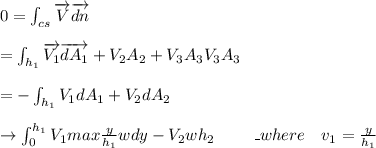
Physics, 26.10.2020 17:20, tonydeanfbg8706
A two-dimensional reducing bend has a linear velocity profile at section 1 . the flow is uniform at sections 2 and 3. the fluid is incompressible and the flow is steady. find the maximum velocity, v1max at section 1.

Answers: 2
Other questions on the subject: Physics

Physics, 21.06.2019 17:30, TropicalFan
How does convection affect our atmosphere? our layers of earth? our oceans?
Answers: 3

Physics, 22.06.2019 12:20, drewefielder6198
Which of the following situations is impossible? a) an object has velocity directed east and acceleration directed east. b) an object has zero velocity but non-zero acceleration. c) an object has constant non-zero velocity and changing acceleration. d) an object has velocity directed east and acceleration directed west. e) an object has constant non-zero acceleration and changing velocity.
Answers: 2

Physics, 22.06.2019 14:30, Paigex3
In order to do work, the force vector must be question 1 options: in a different direction than the acceleration vector. in a different direction than the displacement vector. in the same direction as the displacement vector and the motion. in the same direction as the acceleration vector.
Answers: 1

Physics, 22.06.2019 15:00, koranbutterton
Astudent throws a water balloon with speed v0 from a height h = 1.76 m at an angle θ = 21° above the horizontal toward a target on the ground. the target is located a horizontal distance d = 9.5 m from the student’s feet. assume that the balloon moves without air resistance. use a cartesian coordinate system with the origin at the balloon's initial position. (a) what is the position vector, rtarge t, that originates from the balloon's original position and terminates at the target? put this in terms of h and d, and represent it as a vector using i and j. (b) in terms of the variables in the problem, determine the time, t, after the launch it takes the balloon to reach the target. your answer should not include h. (c) create an expression for the balloon's vertical position as a function of time, y(t), in terms of t, vo, g, and θ. (d) determine the magnitude of the balloon's initial velocity, v0, in meters per second, by eliminating t from the previous two expressions.
Answers: 3
Do you know the correct answer?
A two-dimensional reducing bend has a linear velocity profile at section 1 . the flow is uniform at...
Questions in other subjects:











 "
"
![\to V_3A_3= V_1 max [\frac{y^2}{2h_1}]^{h_1}_{0} -V_2wh_2 \\\\= \frac{V_1 max}{2} \times wh_1 -V_2wh_2 \ \ \ \ \ \ \ \ \ \ \ \ \ \ \ \ \ A_3 =w_3h_3\\\\\to \frac{V_3A_3}{w}= \frac{V_1 max}{2} \times h_1 -V_2wh_2 \\\\ \to V_3h_3= \frac{V_1 max}{2} \times h_1 -V_2wh_2 \\\\\to 5 \times 0.15 = \frac{V_1}{2} \times 0.5 - 1 \times 0.2 \\\\V_1 = 3.8 \ \frac{m}{s}](/tpl/images/0840/4123/a88e0.png)






